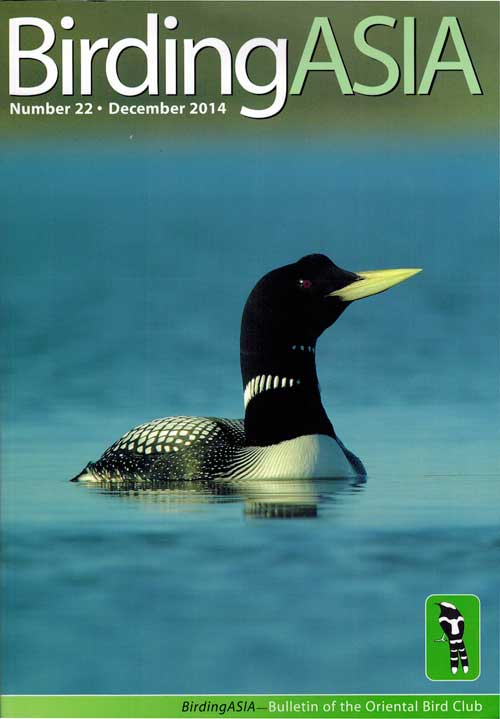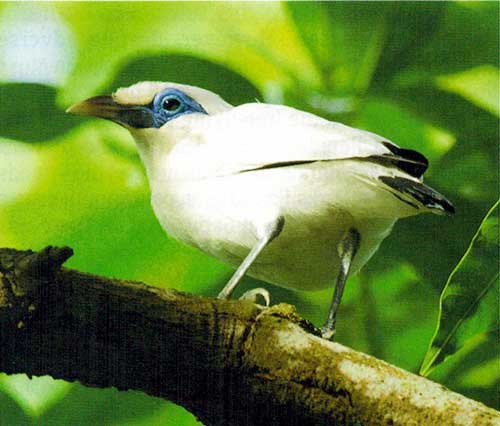Bali mynah (Dijkman, 2014)
Godi Dijkman describes recent breeding and release developments of the Bali starling in 2014, in Nusa Penida and the West Bali National Park. Below article was published in BirdingASIA no. 22, December 2014, which only reached its readers second half of March 2015. The author wishes to thank both Bayu Wirayudha at Friends of the National Parks Foundation (www.fnpf.org) and Nana Rukmana at the West Bali National Park for their invaluable information. More information on FNPF conservation endeavours for the Starling can be found at: http://www.fnpf.org/what-we-do/nusa-penida-bali/wildlife/bali-starling-conservation-project. In addition, recent information on breeding projects of this beautiful Balinese bird by the Begawan Foundation (Sibang, Bali) may be found at: www.begawanfoundation.org/?idm=8.
Bali Myna (Leucopsar rothschildi): brighter prospects for the future?
 Compared with the situation in 2007 (Dijkman, 2007), the overall status of the wild population of the Bali Myna Leucopsar rothschildi, talisman of Balinese fauna, has greatly improved. Numbers have risen in both the Taman Nasional Bali Barat (West Bali National Park) and Nusa Penida and the future for this charismatic bird looks brighter. Moreover, the success of the Bali Myna has had a positive impact on other species.
Compared with the situation in 2007 (Dijkman, 2007), the overall status of the wild population of the Bali Myna Leucopsar rothschildi, talisman of Balinese fauna, has greatly improved. Numbers have risen in both the Taman Nasional Bali Barat (West Bali National Park) and Nusa Penida and the future for this charismatic bird looks brighter. Moreover, the success of the Bali Myna has had a positive impact on other species.
Taman Nasional Bali Barat (TNBB) officials state that currently there are some 120 birds in the breeding centre there, whilst there are about 35 free-flying birds in the park, with an estimated total wild population in the area of about 40 birds. Various organisations are involved in the breeding and release programme, co-ordinated by the Bali Myna Conservation Association (APCB). Japan's Yokohama Zoo has contributed birds for the breeding programme over the last few years, while Taman Safari Indonesia and Bali Bird Park have also participated in the conservation efforts. The present TNBB breeding programme commenced in 1996, with the first birds released into the park in 1998. Its main objective is to involve the local community around the park, including ex- poachers, in breeding the Bali Myna partly for commercial purposes and partly for release into the wild. So far, loans extended to breeding efforts are organised by the APCB. Since 2012, more than 60% of the birds bred by local communities have been released while simultaneously the restoration of the bird's natural habitat is given priority. In 2015, TNBB hopes to achieve a total wild population of around 60 birds, but the attainment of this goal depends on the help of the local population to gradually return the habitat to its original state and ensure poaching and theft are stopped. One of the more daunting challenges is curbing the ubiquitous invasive Lantana camara, which often out-competes native plants, forming dense thickets if unchecked, leading to a reduction in biodiversity.
At present, on Nusa Penida (Dijkman 2007) there are reported to be some 100 free-flying Bali Mynas, including about 20 birds on Nusa Lembongan. Unfortunately in 2014, although there are an estimated 13 breeding pairs, only five chicks were successfully fledged in the wild - many others fell victim to predators and the climate. In 2013, estimated numbers were slightly higher and the reduction is believed to be due to several factors. Predators such as rats, monitor lizards (Varanus salvator), snakes and Tokay Gecko (Gekko gecko) steal eggs and prey on chicks in nest boxes and natural breeding sites. Brahminy Kites (Haliastur indus) and Changeable Hawk Eagles (Nisaetus cirrhatus) prey on adult birds. More surprisingly perhaps, Bali (p.106) Myna nests are taken over by honeybee colonies causing adults to desert them. However, the most voracious predator appears to be the Spotted Kestrel (Falco moluccensis), which, being about the same size as an adult Bali Myna, is well able to enter nest holes in search of prey. The weather on Nusa Penida, which is hot in comparison with mainland Bali, also takes a toll on chicks, which have been found dead after particularly cold nights, a common feature of the hot dry season. However, despite adverse weather and predatory animals, conditions on Nusa Penida are favourable, and for 2015 hopes are high for an increase in the free-flying population.
 Image left (plate 1): Bali Myna Leucopsar rothschildi, Taman Nasional Bali Barat, Indonesia, 19 July 2009 (James Eaton)
Image left (plate 1): Bali Myna Leucopsar rothschildi, Taman Nasional Bali Barat, Indonesia, 19 July 2009 (James Eaton)
On Nusa Penida the species is found at Pura Puseh in the highlands, at Sental, around the Friends of the National Parks Foundation community centre at Ped (www.fnpf.org), at Sebunibus and on Nusa Lembongan. It prefers locations with medium-size trees which provide an abundance of different species of insects, as at Sebunibus. Nusa Lembongan has become a favourite Bali Myna site because the island is densely populated and the birds find easy meals in the form of temple offerings of rice and other edible items, as well as feeding on the many papaya trees, another favourite food, in the local gardens and on naturalised Jamaican cherry trees (Muntingia calabura). The mangrove forests on Lembongan, particularly at Puaji temple, Jungutbatu, offer a wide variety of insects and have also become a favourite habitat of the species. The Bali Myna has not yet spread to the higher altitudes on Nusa Penida such as the forested areas of Saab and Bukit Mundi with tall trees growing in the vicinity of the local temples, as it appears to prefer medium-sized trees, bushes and undergrowth.
As far as the anthropogenic factors contributing to the conservation of Bali Myna and other species are concerned, the traditional religious awig-awig code of conduct adhered to by the Hindu community on Bali greatly favours future success. In Balinese villages, two forms of governance work together in harmony to achieve a peaceful village life - the Bali provincial regulations based on the basic law of Indonesia and the traditional awig-awig village governance made through collective deliberation under the guidance of the religious leaders which is tailored to the conditions and circumstances in each village. In 2007, there were about 25 traditional villages adhering to these religious regulations, whereas in 2014, 46 are likely to adopt the awig-awig laws. The way these laws are maintained depends on the view taken by the community leaders of the presence of the Bali Myna in their village. In other words, the religious leaders hold the key to implementing these laws and sanctions, and despite rumours of illegal poaching there is no evidence for this occurring.
At the outset, there were critical comments on the effect the introduction of Bali Myna to Nusa Penida in 2006 might have on other bird species thought to be its natural competitors, including the Critically Endangered Black-winged Starling (Acridotheres melanopterus). At first, the Black-winged Starling only seemed to live around Wates, but recently it has been observed in other areas including Nusa Lembongan, in company with the White-vented (Myna A. javanicus), and the three starling species have been observed living together peacefully around Puaji temple at Jungutbatu where the larger trees provide numerous holes for nesting.
 Image right (plate 2): Bali Myna Leucopsar rothschildi, Nusa Penida, Indonesia, 27 May 2013 (Justin Raybouin)
Image right (plate 2): Bali Myna Leucopsar rothschildi, Nusa Penida, Indonesia, 27 May 2013 (Justin Raybouin)
The introduction of the Bali Myna to Nusa Penida has triggered interest in saving other bird species as well. Although initial attempts to reintroduce the Critically Endangered Yellow-crested Cockatoo (Cacatua sulphurea parvula) to the island were met with a positive attitude from the local population, for instance at Sekartaji, they failed due to predation by eagles. However, in the near future, attempts to breed this cockatoo are planned as large flocks of this bird once occupied the entire island. In 2007, the Near Threatened Scarlet-breasted Lorikeet (Trichoglossus forsteni mitchellii) population of ex-cage birds died out due to old age, but it is evident that this bird is perfectly able to survive on Nusa Penida. Previous attempts to revive the old numbers of the Vulnerable Java Sparrow (Lonchura oryzivora) have failed, but hopes are rising again due to its hitherto unsuspected 'companions' Dicrurus sp. which, thanks to their vigorous territorial behaviour, drive out the sparrow's foremost enemy, the ubiquitous Long-tailed Shrike (Lanius schach).
The introduction of the Bali Myna to Nusa Penida has inspired other wildlife sanctuaries, such as the Besikalung Wildlife Sanctuary, near Jatiluwih, Batu Karu, Tabanan, initiated in 2011. Similar awig-awig religious governance to those on Nusa Penida also apply here and the area has been identified for future breeding and release of Black-winged Starling and Asian Pied Starling (Sturnus contra jalla). In 2014, a similar project was started at Pejeng Wildlife Sanctuary, near Ubud, Gianyar Regency, Bali. An additional Bali Myna breeding centre is planned here, expecting to release the birds in the wild, involving the local inhabitants who are willing to co-operate in the breeding and release project.
Reference
- Dijkman, G. (2007) - 'Bali Myna (Leucopsar rothschildi) takes flight to Nusa Penida', in: BirdingASIA 7, 2007: p.55-60, http://nusapenida.nl/index.php/balistarling/bali-starling/balimynah-dijkman2007
- Friends of the National Parks Foundation, FNPF (www.fnpf.org; Bayu Wirayudha, bayu [at] fnpf.org), interview summer 2014
- West Bali National Park, TNBB (Nana Rukmana, rukmana_tnbb [at] yahoo.com), interview summer 2014
Source
- Dijkman, G. (2014) - 'Bali Myna (Leucopsar rothschildi): brighter prospects for the future?'; in: BirdingASIA 22, 2014: p.105-106


 design: Caro Dijkman -
design: Caro Dijkman -